|
"Those who cannot remember the
past are condemned to repeat it." That line from George Santayana's
The Life of Reason: Reason in Common Sense (p172) always comes to mind
whenever I see articles from vintage publications about how people at the time were
being forced to defend their ways of life from maniacal would-be dictators who marshaled
armies of like-minded crazies to invade and attempt to subdue other countries and/or
citizens within their own borders. It seems after a generation or two of comfortable,
relatively safe existence, the collective guard is lowered and the hard-lessons
from history are forgotten or subversively erased from memories. This particular
1944 Radio News magazine article tells the story of women of European
Allied nations
- in particular Polish women - taking up arms against
Axis powers (Germany and
Italy) during World War II.
Part of the survival effort included learning to operate and service communications
equipment in order to provide surveillance and security both on the battlefield
and in helping countrymen escape the incursion. Some were captured, and many became
part of the millions of Poles taken from their homes and sent to Nazi prison camps
and slave factories. Today in America, we have a large population of people adopting
the mindset of Communist and Socialist dictator-run countries our ancestors sacrificed
to defeat. Many are in high political office and appointed service positions. The
words of a famous actor still ring true, "We will preserve for our children this,
the last best hope of man on earth, or we will sentence them to take the first step
into a thousand years of darkness." Seems to me our feet are at the precipice.
Women Radio Commandos

Radio transmitter used at a Polish woman commando camp in Britain.
Many of these women were skilled technicians before the war.
By Kenneth R. Porter
Radio News War Correspondent
Fighting with the Allies for Poland's liberation, the women of the P.S.K. are
receiving training in all methods of warfare, including most types of communications.
Bleak and dismal, the Scottish cliffs overlooking the North Sea provide a perfect
setting for one of the most stirring sights to be seen on all of the British Isles.
Far above the roar of waves dashing against rock comes the sound of gunfire. And
through the perpetual mist that eerily silhouettes all it touches, figures throw
themselves flat, aim rifles, and then leap forward to another firing position.
The figures are worsen, Polish women in whom wild, unreasoning hate is being
molded into a, sound, effective striking force. They are undergoing commando type
training. To them it is mild compared with what they have been through in actual
warfare.
The way they run, the purposeful manner with which they aim and fire, the harsh
battle cries that issue almost unconsciously from their throats, bode no good for
any hapless Nazis who might be caught before a charge of these petticoat commandos.
These women would like to fight shoulder to shoulder with their countrymen in
Great Britain and Russia who are poised to help their allies crack Hitler's "Fortress
of Europe." They would like to kill Germans - lots of Germans. They may - in extreme
emergencies - but primarily they are technicians whose chief work is close to the
front lines, but not on the front lines.
Hundreds of them, beside their battle training, are attending highly-specialized
schools where the curriculum includes advanced instruction in telephone, telegraph,
teletypewriter, television, and other types of radio communication.
Many of the petticoat warriors were skilled electrical or radio technicians before
the outbreak of war. Some hold degrees in radio engineering and allied sciences.
All know the desolation and hardship of flight before the Nazi invaders and the
bitterness of life in a strange land where their hate was fed daily with new stories
of what the Germans were doing to their homeland, and their less fortunate brothers
and husbands.
Now, as members of the reorganized P.S,K. (Pomocnicza Sluzba Kobiet), the Polish
equivalent to the British Auxiliary Territorial Service and the American Women's
Army Corps, they are prepared to add further to the history of the P.S.K.
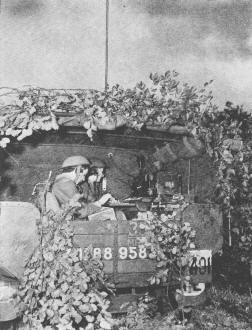
Women commandos obtaining experience, in the operation of mobile
radio equipment.
The organization is not new. It existed in Poland before the war. It has been
through fire and pillage, occupation and exile. Its full part in Poland's struggle
against tyranny will not be known until the war is ended.
How the P.S.K. came into being again is a story in itself. It starts with the
Nazi invasion.
When Hitler struck, the old P.S.K. was, as it is now, primarily a communications
outfit. Many of the veteran officers and instructors of the present signal section
recall vividly the trying days of September, 1939, when through their untiring efforts
communications were kept open without a break for 22 days - the last phase of the
fight for Poland. Their gallant stand made it possible for thousand of troops to
escape over the Hungarian frontier without the loss of materials and with a minimum
loss of men.
Some of the women were attached to the Tank Division, commanded by General Stanislaw
Maczek, which covered this orderly retreat in the face of overpowering Nazi forces.
Their job was at the mobile field radio stations and message centers.
But while they helped their men escape, few of the women were so fortunate. Instead
they were captured, and many became part of the millions of Poles taken from their
homes and sent to Nazi prison camps and slave factories.
A considerable group fled east, where Russians, then biding their time so that
they would be prepared for the inevitable Nazi blow at Russia, took the girls prisoner.
They were sent to isolated rural areas. Those with professional or scientific knowledge,
especially in communications, dared not reveal their background.
Unaccustomed to any sort of manual labor, these experts were put to work on farms
and kilns. They were luckier than those captured by the Nazis, for those unfortunates
were cutting timber and working in mines where, if they died, were left in natural
graves far below the earth's surface.
Although those in Russia were under strict surveillance, too, they soon built
up an underground communications system with their German-held sisters. This system
flourishes today, working relentlessly for the Allies.
The Russian-Polish agreement signed by Stalin and the late Wladyslaw Sikorski
in Moscow in July, 1941, freed thousands of girls to fight again for their country.
They began a great trek southward to Buzuluk, a hundred miles east of the Volga.
They went by foot, sometimes with luck by boat or in slow-moving trains. At Buzuluk,
an oasis for Poles, these stragglers were greeted by their own people. The P.S.K.'s
reorganized and began work again with Polish troops. Reverses of the war, however,
forced them to evacuate and finally, by a circuitous route through Iran, Iraq, Persia
and Palestine, the first small group of P.S.K.'s eventually reached the rugged and
friendly shores of Scotland.
They had circled half the globe by this time; but during their travels they trained,
learning to drive, to code and decode signals, to operate the newer type radio transmitters
and receivers, to handle arms, to perfect themselves in nursing and, of course,
to master the English language.
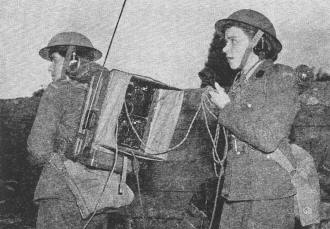
Airplane spotter team reporting the location of enemy planes
to headquarters.
Now, under the direction of Lt. Col. Maria Lesniak, Commandant of the Polish
A.T.S. (P.S.K.), these women receive specialist training in all of warfare's grim
departments. Because of their natural aggressiveness and attention to duty they
have quickly become superior to their brother signalmen in communications work.
"They have learned to withstand the physical hardships of their work as readily
as men and they must be able to use all of the weapons of war for their own defense,
when the time comes," said Colonel Lesniak. "They are naturally qualified for radio
and communications work and are without question more adept in its operation than
men."
Such a statement might be challenged if made by any other than a good-looking
commandant - but who wants to disagree with a lady, especially a lady commando!
One of the P.S.K.'s. favorite types of equipment is the same mobile field radio
station they used under General Maczek. It is the "Number 1-3." This set designed
for Cavalry and Mechanized Service, resembles in its simplicity some of the characteristics
of the famous U. S. Army mobile set known as the SCR-299. So compact, flexible and
serviceable were the "Number 1-3" sets that even today they are being used as a
part of the basic training course of the women commandos.
The most outstanding feature of this mobile field equipment, which at the time
of its use in combat differed from that employed by armies of other nations, is
the exceptionally easy calibration of the radio receiver and the stabilization of
the transmitting device, without the necessity for using crystals. Another feature
is that it can be operated in motion without an antenna and yet cover a range of
m than 30 miles.
Instruction pamphlets on the use the set specifically state that the call letter
should never be used more than three times when signaling a station. A single movement
of the key by the operator giving the correct call letter should be quite sufficient
for contacting another station.
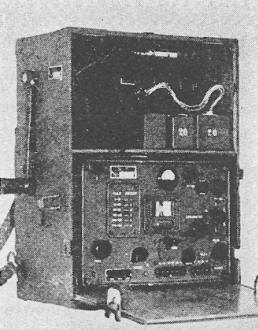
Prewar Polish-made model, type "N2-WZ37", made in 1937 - Transmitter
from mobile field radio set.
Interception by the enemy is virtually impossible due to the high perfection
of calibration which permits the use of the set for special liaison work. Each station
has its own frequency and each station frequency differs from the other. It is possible
to change frequency in a split second, however and thus attain the variable frequency
so the transmitter can reach the receiver of any of the other stations almost instantly.
The enemy is therefore unable to tune in or intercept the messages being sent, which
is a desirable condition.
The station was originally built to make possible its operation under the worst
imaginable field conditions and is mounted on a two-wheeled trailer chassis. Power
for its operation can be generated manually, either by hand or foot or by a small
engine which normally is carried in another vehicle, It contains two separate radio
compartments, one forward and one to the rear of the center control panel. During
its combat use in the early stages of the war, it was the principal radio apparatus
of Polish division and brigade headquarters.
Smaller troop units such as battalions and regiments used a similar type station,
designed in 1937 and known as the "N2-WZ37" which was employed very successfully
against the enemy. It was more compact than the "Number 1-3" although it had the
same qualities in transmission and reception and like all Polish mobile units it
had special facilities for communication with aircraft.
The carriage appeared outwardly very similar to its larger counterpart but the
operator sat in the seat in the rear with the instruments in a boxed-in panel in
the front. The entire unit could be trailed behind any motorized or horse-drawn
vehicle.
It contained a transmitter capable of sending messages a distance of from six
to eight miles by telephone and about fifteen miles by telegraphic code on an aerial
20 feet in length. With a shorter aerial, 2 1/2 feet long, it had a range of three
miles with the telephone, and from six to eight miles by telegraphic code. It operated
on a frequency of from 2250 kilocycles to 6750 kilocycles. Power was produced by
a hand-cranked generator supplied with the unit, which obviated the necessity for
batteries.
Both the transmitter and receiving apparatus could be readily removed from the
trailer carriage and used as fixed equipment by foot soldiers. Due to its weight
it was designed to be operated by three persons when employed as a temporary ground
station.
A still smaller station type, known as the "S," was utilized for front line troops.
A superheterodyne receiver was employed even though most equipment being used by
other troops at this time was of the basic detector and audio amplifier type.
Many of the features of Polish radio equipment were of German origin since the
Poles had relied for many years on German-made sets. It was only after the Soviet-Polish
War in 1920 that military radio equipment was developed to "any extent by the Poles.
During the intervening years, however, up to the outbreak of hostilities in 1939,
they had built up reserves sufficient to equip at least four armies of from 40 to
50 divisions. This included, besides mobile equipment, sets similar in design and
purpose to the walkie-talkie and handle-talkie now in use by Allied troops. They
were serviceable, rugged and measured up favorably to other apparatus being used
at that time.
At the height of the Nazi invasion most of this equipment was destroyed and the
huge factories, including the Electrit in Vilno, Ica in Lody and the Telefunken
(German branch) and Phillips in Warsaw, were put on a mass production basis under
forced women labor, producing radios for Germany. Most of the male Morse operators
and radio experts were either evacuated or shot by the invasion forces. It was in
these factories that many members of the present Polish P.S.K., who were fortunate
enough to escape, received their elementary training in radio maintenance, repair
and operation.
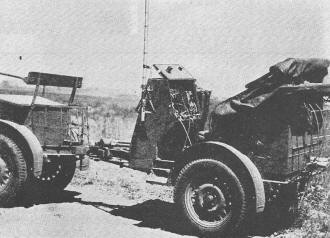
Prewar Polish-made model, type "N2-WZ37", made in 1937 - Mobile
unit complete with radio equipment. Like all Polish mobile units, this has special
facilities for communications with aircraft.
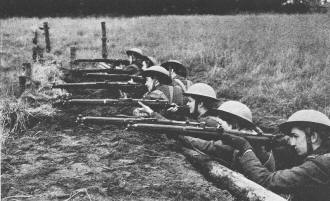
Firing at moving targets from a muddy rifle range, these women
undergo commando type training. Their wild hate is being molded into a sound and
effective striking force.
Although various American and British exchange and financial agencies have made
available modern equipment, most of the military and commercial maritime radio sets
in use on Polish ships are of their own pre-war design and manufacture. The Polish
Technical Division now attached to British research laboratories, with engineers
working in British war production, have developed and carried on exhaustive research
on many radio devices used both by the Polish air and ground forces.
Allied experts have recognized many Polish radio inventions as being products
of the highest skill and although it is impossible to make public what all of them
are, they are considered a real contribution to the war effort. One is a miniature
hand radio set for use with paratroops and a series of small ground sets perfected
in the past year which already have found favor among the various services.
With the introduction of American and British radio equipment, a complete new
system of training became necessary for the Polish P.S.K. girls. They quickly mastered
the technique of the more modern apparatus, however, as in most instances they had
been trained on similar equipment that has become obsolete through capture by the
enemy or further development by engineers.
Fundamentally their course is practically identical to that of the male signalmen.
Candidates are selected from the ranks of the battalions and they need only to pass
a rather elementary aptitude test to become eligible for signal training. If any
of the women prefer aviation communications, a special course is provided.
After watching these hardy daughters of Poland go through combat maneuvers in
full battle dress of British khaki and steel helmets one realizes they are not carrying
rifles, throwing grenades or operating radios for the sheer love of duty alone.
They're fighting their way back home!
Posted July 6, 2021
|















